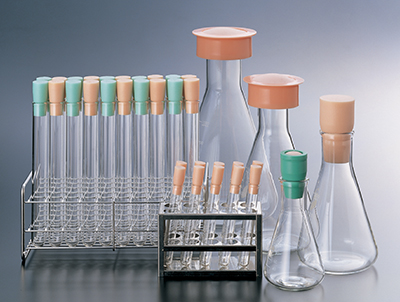

SILICOSEN
A silicone plug that transformed the history of culture plugs dating back over 100 years.
SILICOSEN was jointly developed over 40 years ago.
In SILICOSEN, the traditional cotton material used for culture plugs was replaced with silicone. This attracted the attention of microbiologists because it was such an epoch-making invention, providing them with far greater convenience.
This is the secret story behind SILICOSEN, which looks back at the epoch-making invention that became useful for society.

Birth and development of SILICOSEN
To discuss the birth and development process of SILICOSEN, we talked to Dr. Kazuhide Yamasato, a former professor at the University of Tokyo, who was involved in the joint development of SILICOSEN, which would play a role in the culturing process of microorganisms that are so essential for our lives.
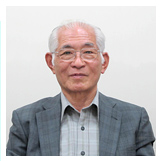
Dr. Kazuhide Yamasato
Born in 1933. Graduated in Agricultural Chemistry, Faculty of Agriculture, the University of Tokyo in 1956. Completed his doctoral course in the Graduate School of Agriculture, the University of Tokyo in 1964. Holds a Doctor of Agriculture (Agricultural Chemistry). He took up the position of assistant at the Institute of Applied Microbiology, the University of Tokyo (microbial taxonomy) in 1965. He then worked as an assistant professor and a professor. He retired in 1993. He worked as a commissioned professor of the Graduate School of Tokyo University of Agriculture (zymurgy) between 1997 and 2003. His specialization is microbial taxonomy and microbial systematics/collection. He served as chair of the Japan Federation of Culture Collections (now the Japan Society for Microbial Resources and Systematics) as well as chair of the Japanese Soc. for Res. of Freezing and Drying (now the Japanese Society for Cryobiology and Cryotechnology).

Culture plugs: essential in the culturing process of microorganisms
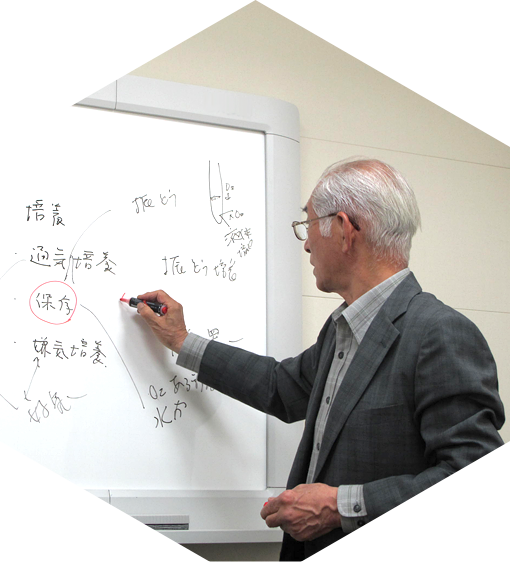
Test tubes containing culture medium and culture plugs that prevent unwanted bacteria floating in the air from entering the tube are the most essential items of equipment for researchers like us who culture and collect microorganisms (such as molds and bacteria). Prior to 1970, I worked in the microbial taxonomy/collection department of the Institute of Applied Microbiology, the University of Tokyo (now the Institute of Molecular and Cellular Biosciences). I was then transferred to a newly established department called the Institute of the Preservation of Beneficial Bacterial Strains. In this department, we chiefly carried out the collection and preservation of a vast number of bacterial strains. We also provided both domestic and overseas microbiologists (who worked for research institutes of public or private companies) with these bacterial strains. The vast number of bacterial strains had to be cultured, preserved, and then distributed. Each test tube had to be sealed with a rounded cotton plug made individually by hand. A new cotton plug was prepared each time because they could not be recycled, which took an enormous amount of time. On the other hand, the workforce could not be increased following the national policy on personnel reduction. We were therefore forced to produce cotton plugs ourselves, and important microbial research was impacted as a result. Cotton had been used for culture plugs for over 100 years. Under the circumstances, I decided to develop a culture plug that would replace the cotton plug, a ready-to-use and recyclable plug that was not handmade and that would allow oxygen and carbon dioxide to pass through it in and out of test tubes, yet prevent unwanted bacteria from entering.

The needs of the researchers matched with the seeds of the manufacturer
When I began searching for alternative materials, I found out about the cylindrical-shape urethane culture plug that was used in the U.S. However, there was a critical flaw in the culture plug. Before culturing any microorganism, it is necessary to carry out a process in which test tubes containing culture medium that are sealed with a culture plug are sterilized at a high temperature (120ºC) in order to kill unwanted bacteria found in the culture medium or adhering to the culture plug. After this sterilization process, the inserted part of each urethane plug became marked and narrowed, which allowed unwanted bacteria to easily enter the test tube. Most of all, this type of culture plug was not recyclable and had to be discarded after use.
This was the reason I began searching for an alternative material with a restoring force at stores that sold medical and physicochemical equipment, often located in the area around the University of Tokyo. At just around the same time, Shin-Etsu Polymer developed a silicone rubber with continuous bubbles*1, and was distributing samples to medical and physicochemical-related trading companies in order to search for uses and obtain information for them to use during its development. I contacted Shin-Etsu Polymer and explained that plugs called cotton plugs were used in the culturing process of microorganisms. I then asked whether they would be able to produce an alternative to the cotton plugs using the silicone rubber with continuous bubbles. If I had visited the stores that sold medical and physicochemical equipment a little sooner than the visit paid by Shin-Etsu Polymer for the purpose of sample distribution, I would not have had the opportunity to see the silicone rubber with continuous bubbles, and I may have given up hope of finding an appropriate material. This was a lucky coincidence whereby my needs and their seeds crossed paths.
*1:
SILICOSEN, silicone rubber with continuous bubbles
Large, visible holes run through SILICOSEN from top to bottom, but miniscule, invisible bacteria are prevented from passing through the holes. The principle is based on the swan’s neck (neck of swan)*.
*Swan’s neck (neck of swan)
A narrow, curved tube that resembles a swan’s neck only allows air to pass through, but not bacteria.
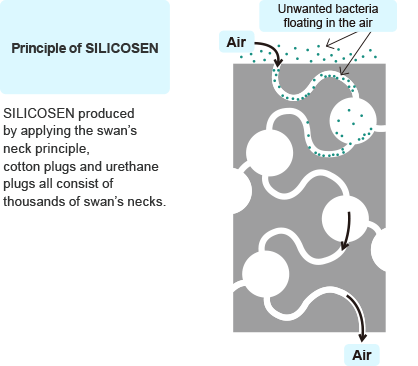
In the mid-19th century, there was a major debate surrounding the theory of the spontaneous generation of life, and the theory that said that life was born only from life. When nutrients (meat broth) were placed in a container and cooked before being sealed, they did not decay even if left for some time. This appeared to reject the theory of spontaneous generation, but some people brought forward a counterargument, saying that the airtight condition prevented decay because something in the air that was essential for generating life was missing in the container. On the other hand, Louis Pasteur placed nutrients in an open container, sterilized it with heat and left it for some time. The meat broth did not decay, and thus he demonstrated the fundamental principle that life is born only from life. The opening of the container used by Louis Pasteur was narrow, long and curved, just like a swan’s neck. It allowed air to pass through but prevented bacteria found in and around the opening from doing so and therefore, in contact with the external atmosphere, from reaching the meat broth as they were stuck in the middle.
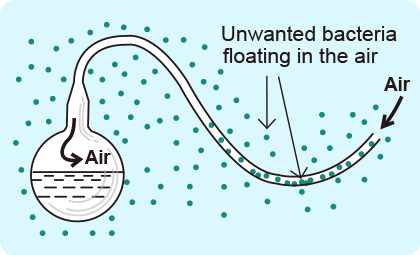

A product that becomes useful in society
Introduce the silicone product to the world
I carried out an evaluation of the sample produced by Shin-Etsu Polymer across four items:
- Whether unwanted bacteria stray into test tubes,
- Permeability,
- Holding force (adhesion between test tube and culture plug) as to how easily it can be removed from the test tube, and
- Moisture evaporation during preservation after the culturing process is completed (if the culture medium becomes dry, the microorganisms will die).
The permeability of the silicone rubber with continuous bubbles was not as good as cotton plugs. However, moisture evaporation was significantly reduced due to its hydrophobic property. It also had excellent heat resistance and was durable compared to urethane, so it could be used over and over again. We found out that the functionalities of the silicone rubber with continuous bubbles were adequate as an alternative to cotton plugs. We worked jointly on the productization so that it could be used in the culturing process of aerobic bacteria*2, and after a few years, we successfully developed BIO-SILICO with improved permeability.
With SILICOSEN, I no longer needed to produce cotton plugs, and this allowed me to dedicate my time to research. Over a long period of time, SILICOSEN helped free many microbiologists from the troublesome task of producing cotton plugs, and saved an enormous amount of time. This is a characteristic contribution, different from those made by other new precision equipment.
Over 40 years have passed since then. Thanks to its superior properties, SILICOSEN has become so well known that it is difficult to find microbiologists who do not know about it. I wish to actively promote this convenient product, not only in Japan but also overseas, so that researchers around the world can start using it.
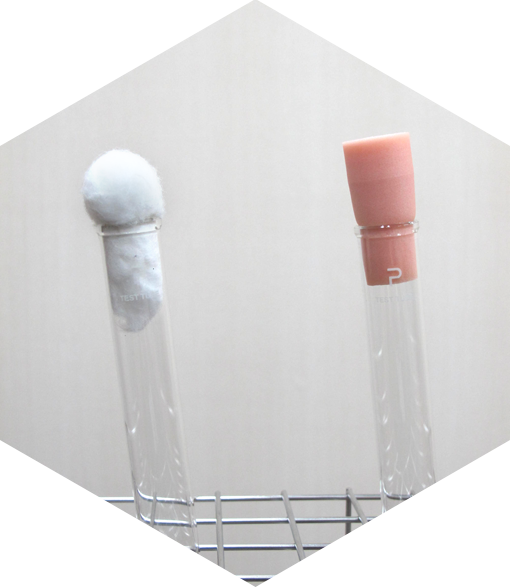
*2:
A type of bacteria and ventilation volume
Aerobic bacteria: Bacteria that require air for their development and multiplication. They oxidize glucose, converting it into carbon dioxide and water to obtain energy in the same manner used for the breathing process in humans.
